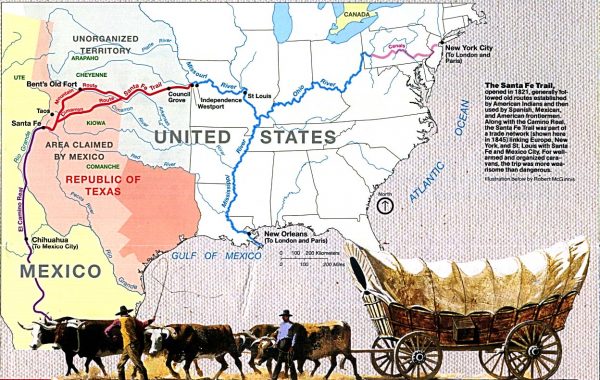During the nineteenth century the Santa Fe Trail played an important role in the westward expansion of the United States. Both a trade route and an emigrant road, the Santa Fe Trail traversed the southwest, originating in Missouri and traveling south to Santa Fe in Neuevo Mexico. Much of it passed through present-day Colorado.
The origins of the Santa Fe Trail go back at least to the 1700s and perhaps earlier. Native Americans established parts of what would become the trail, as did Spanish and French traders. Fur traders and mountain men from the United States began using the trail in about 1821 or ’22, mainly for trade with Mexico. Heading southwest from Missouri, much of the trail followed the Arkansas River. In present day Kansas it split into two routes. The southern route crossed the Arkansas and the Cimarron River, passing through what is today the southeastern corner of Colorado and the Oklahoma panhandle into New Mexico. There was little water along the route, leading the Spanish to call it La Jornada del Muerto – “dead man’s journey.” The northern, or mountain, route of the Santa Fe trail continued along the Arkansas River in present-day Colorado, eventually reaching Bent’s Fort and then continuing south over Raton Pass into New Mexico.
 By the 1840s the trail was being used by pioneers; Susan Shelby Magoffin, who traveled the Santa Fe Trail in 1846, is said to be the first white woman to travel west on the trail, although many Mexican and Native American women had preceded her. Magoffin visited Bent’s Fort, which she described in her diary. Bent’s Fort, and Magoffin, are highlighted in a 1977 Colorado Magazine article, “Life in an Adobe Castle, 1833-1849.” (For additional articles and resources on Bent’s Fort, see my previous blog post.) During the Mexican War of 1846-48, the trail was used by the U.S. Army. After the war and the Treaty of Guadalupe Hidalgo, more American settlers began moving West along the Santa Fe Trail. Even more settlers followed during the gold rushes and in the years after the American Civil War; some, instead of just passing through, decided to stay. For instance, the town of Boggsville, near the confluence of the Arkansas and Purgatoire Rivers, was founded by farmers in 1866. Hispano settlers also made their homes in the area. Felipe Baca, originally from New Mexico, settled in the area around what would become Trinidad, Colorado. He invited twelve other Hispano families to join him, and by 1866 the town was thriving, with commerce from the nearby trail.
By the 1840s the trail was being used by pioneers; Susan Shelby Magoffin, who traveled the Santa Fe Trail in 1846, is said to be the first white woman to travel west on the trail, although many Mexican and Native American women had preceded her. Magoffin visited Bent’s Fort, which she described in her diary. Bent’s Fort, and Magoffin, are highlighted in a 1977 Colorado Magazine article, “Life in an Adobe Castle, 1833-1849.” (For additional articles and resources on Bent’s Fort, see my previous blog post.) During the Mexican War of 1846-48, the trail was used by the U.S. Army. After the war and the Treaty of Guadalupe Hidalgo, more American settlers began moving West along the Santa Fe Trail. Even more settlers followed during the gold rushes and in the years after the American Civil War; some, instead of just passing through, decided to stay. For instance, the town of Boggsville, near the confluence of the Arkansas and Purgatoire Rivers, was founded by farmers in 1866. Hispano settlers also made their homes in the area. Felipe Baca, originally from New Mexico, settled in the area around what would become Trinidad, Colorado. He invited twelve other Hispano families to join him, and by 1866 the town was thriving, with commerce from the nearby trail.
Over the next few years, however, the Atchison, Topeka, and Santa Fe Railroad would reduce the need for the Santa Fe Trail, which was mostly abandoned by 1880. In its heydey, however, the Santa Fe Trail served as a vital link between the United States and the lands acquired as part of westward expansion. Today, you can still visit parts of the old Santa Fe Trail. Bent’s Old Fort has been reconstructed and is open as a museum; it is also on the National Register of Historic Places and is a National Historic Site. The trail itself has been designated a Scenic and Historic Byway. The Colorado Department of Transportation (CDOT) created a video series on the byway in 2003; you can view it online from our library. The series includes historical information on Trinidad, as well as other historic locations along the byway including Camp Amache and the Sand Creek Massacre site. You can also find more on the Santa Fe Trail Scenic & Historic Byway in CDOT’s 1999 publication Discover Colorado: Colorado’s Scenic and Historic Byways.
Additional resources on the Santa Fe Trail, available for checkout from our library, include
- Historic Resources of the Santa Fe Trail, 1821-1880. Colorado Historical Society, 1993
- The Santa Fe Trail: New Perspectives. University Press of Colorado, 1992
- Colorado Byways: A Guide Through Scenic and Historic Landscapes. University Press of Colorado, 1997
- Bent’s Fort on the Arkansas. Colorado Historical Society, 1954.
- Western Voices: 125 Years of Colorado Writing. Colorado Historical Society, 2004
- Bent’s Old Fort. Colorado Historical Society, 1979
- Trinidad History Museum: A Capsule History and Guide. Colorado Historical Society, 2002

- How to Spot the Differences Between Eagles and Hawks - August 16, 2021
- How Transportation Projects Help Tell the Story of Colorado’s Past - August 9, 2021
- Time Machine Tuesday: The Night the Castlewood Canyon Dam Gave Way - August 3, 2021
